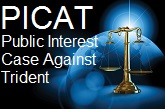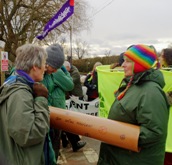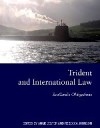by Jo Baker
The use of uranium by the military began with the discovery of the fission process and led to the nuclear programmes in Germany, the US and Britain during the Second World War. In 1945 atomic bombs were dropped on the cities of Hiroshima and Nagasaki in Japan. The US was also concerned that the Germans might use radioactive material as a ground and lung contaminant and US military planners began looking for radioactive material with high gamma and beta radiation and short half-lives which would have an immediate effect on the target population. A declassified US military document of 1943 states:
“From consideration of the possible effects and uses of radioactive material in warfare, it is evident that considerable experimentation with actual field trials would be necessary to determine the optimum conditions under which radioactive dusts could be disseminated with lung contamination and ground contamination.” (1)
The use of uranium as a radiological weapon never materialised, but by the 1950s the US were experimenting with the use of depleted uranium (DU), in anti- tank munitions. A product of the Cold War, it was used in anti-tank penetrators to cut through heavily armoured Soviet tanks. DU trials began in the UK in the 1960s at Eskmeals in Cumbria, although full scale firing did not take place until 1980. DU is a waste product of the enrichment process and the DU used by the military has included uranium extracted from reactor fuel. (2) Its military advantage is that it is a very dense, heavy metal (similar to tungsten) which self sharpens when it hits a hard surface and spontaneously ignites, burning at around 3000–6000 C.
DU penetrators were first tested on the battlefield by the Israelis in the Yom Kippur war of 1973.(3) Their first extensive use was in the Gulf war of 1991 by the British and US. It was estimated that between 300 and 800 tons of DU were used during the six weeks of the Gulf war(4), releasing possible tens of millions of grams of DU oxide into the environment. DU was used again by the US in Bosnia in 1995, Kosovo, Serbia and Montenegro, 1999, continuously in Iraq and Libya 2011. It is also believed to have been used by the Israelis in Lebanon and Palestine and the US in Somalia 1993.
The Mystery
From depleted to un-depleted and enriched uranium?
Since the war of terror began in 2001, independent scientists have been travelling to war zones to collect human and environmental samples and testing them for uranium. Mass spectrometry results show that samples collected from bomb craters, air filters, soil samples and urine contain un-depleted or slightly enriched uranium not depleted uranium.
After the bombing of Afghanistan in 2002, a team from the Uranium Medical Research Center in Canada, took urine samples from civilians suffering symptoms of ‘fatigue, fever, musculoskeletal neurological alterations, headaches and respiratory impairment’. Soil and water samples were also taken from the bombed sites. The mass spectrometry results showed no DU, but high levels of un-depleted uranium, 100 times that of the normal range. Seven residents of Kabul were also contaminated with U-236 which meant that although the uranium had a similar isotopic ratio to natural uranium, it could not have come from a natural source. (5)
In 2006, samples taken from bombed areas in Lebanon and tested at the Atomic Energy Research Establishment at Harwell and the School of Oceanographic Sciences, University of Wales Bangor, again showed no DU but slightly enriched uranium. (6)
A recent study analyzing hair samples from parents in Fallujah whose children had been born with congenital anomalies showed that they had been exposed to significant amounts of enriched uranium in 2004. (7)
The Weapons?
It is no secret that DU has been used in tank armour, anti-tank penetrators and some types of landmine. Jane’s Defence Weekly has also confirmed the use of DU in shaped charge liners and in 2001 the MoD website mentioned British/French trials of DU in shaped charge liners at Aldermaston. (8) US patents cite depleted uranium or uranium metal as a preferred metal in a number of weapon systems including bunker busters and cruise missiles. In 1999, a Decalogue warned troops in Kosovo to ”avoid any medium or material suspected of being hit by munitions containing depleted uranium or Tomahawk Cruise missiles”,(9) and unofficial US military sources have stated its use in large bunker busting weapons such as the GBU-28, (10) 500 of which were shipped to Israel for use in Lebanon in 2006. There is also suspicion that uranium could be used as a reactive metal in thermobaric weapons. (11)
The discovery of un-depleted and slightly enriched uranium indicates a novel use of uranium in undeclared weapon systems. This should be of major concern to the international community because we no longer know what we are dealing with. The international campaign to ban ‘depleted’ uranium weapons is growing apace, but the disturbing and undisclosed use of uranium in other weapons systems by the US and Israel is going unchallenged. The use of uranium in larger weapons would mean is had a more widely contaminating effect. The plumes go high into the atmosphere and are picked up by the air streams. Air filters from Aldermaston show significant radiation peaks after the Tora Bora bombing in Afghanistan, 2002, and the shock and awe bombing of Baghdad in 2003. In both cases the National Oceanic and Atmospheric Administration (NOAA) showed air currents travelling from these regions to the UK. (12)
Uranium weapons, depleted or otherwise, are both radioactive and toxic. The half-life of uranium is 450 billion years. Whereas an atomic bomb releases huge amounts of external radiation, uranium weapons create the risk of internal radiation. Uranium burns at high temperatures creating minute ceramic particles which can be inhaled or ingested. Exposure to uranium dust is known to cause oxidative stress, genomic instability, chromosome damage, neurological problems and kidney dysfunction. Children are particularly at risk from cancers and congenital deformity. In Fallujah, Iraq, 15% of children are now born with congenital malformations, worse than the aftermath of Chernobyl or Hiroshima. Congenital heart defects have the highest incidence, followed by neural tube defects. (13) As, Dr Malak Hamdam, co author of two scientific papers on Fallujah, writes:
“This extraordinary discovery of a new uranium weapon should serve as a wake-up call to the entire world. It is as if the military were at war with humanity, secretively winning their battles with what is effectively a kind of delayed-action radioactive poison gas. They cannot keep denying that these radioactive weapons can discriminate in their effects between military and non-military targets.”
http://childvictimsofwar.org.uk/
http://vandeplaspublishing.com/store/product.php?productid=97&cat=8&page=1
References
- Doctors James B. Conant, Chairman, A.H.Compton, and H.C. Urey, (1943) Use of Radioactive Material as a Military Weapon - Summarised from a report Subcommittee of the S-1 Executive Committee.
- U.S. Information Paper on Depleted Uranium http://www.nato.int/du/docu/d010123a.htm
- Brown, R (19 January 2000)Depleted Uranium Munitions and Assessment of the Potential Hazards DERA Protection Services, Crescent Road, Alverstoke, Hants, PO12 2DL p6 para.17
- Durakovic A (October 2002)New Concepts in CBRN Warfare in the Light of the Gulf War Experience and Current Reality of Global Terrorism The Third GCC Conference of Military Medicine and Protection Against Weapons of Mass Destruction, Doha, Qatar
- http://umrc.net/wp-content/uploads/2012/06/Uranium-Contamination-of-Afghanistan-Tedd-Weyman-2003.pdf
- http://www.greenaudit.org/papers/evidence-of-enriched-uranium-in-guided-weapons-strikes-on-le
- Uranium and other contaminants in hair from the parents of children with congenital anomalies in Fallujah, Iraq. http://www.conflictandhealth.com/content/pdf/1752-1505-5-15.pdf
- Williams, D. Under the radar: identifying third-generation uranium weapons http://www.unidir.ch/pdf/articles/pdf-art2759.pdf
- Zucchetti, M. Cruise missiles with depleted uranium on Libya http://www.voltairenet.org/Cruise-missiles-with-depleted
- Shaft, J U.S. Colonel Admits 500 Tons of D.U. Were Used in Iraq http://www.thecbdf.org/en/cbdf-news/34-press-releases/86-us-colonel-admits-500-tons-of-du-were-used-in-iraq
- Williams, D. Ibid
- Busby, C. Morgan, S. Did the use of Uranium weapons in Gulf War 2 result in contamination of Europe? http://www.greenaudit.org/papers/did-the-use-of-uranium-weapons-in-gulf-war-2-result-in-conta
- Four Polygamous Families with Congenital Birth Defects from Fallujah, Iraq http://www.mdpi.com/1660-4601/8/1/89












 Nuclear weapons crime in the UK has been reported to Thames Valley Police.
Nuclear weapons crime in the UK has been reported to Thames Valley Police.










